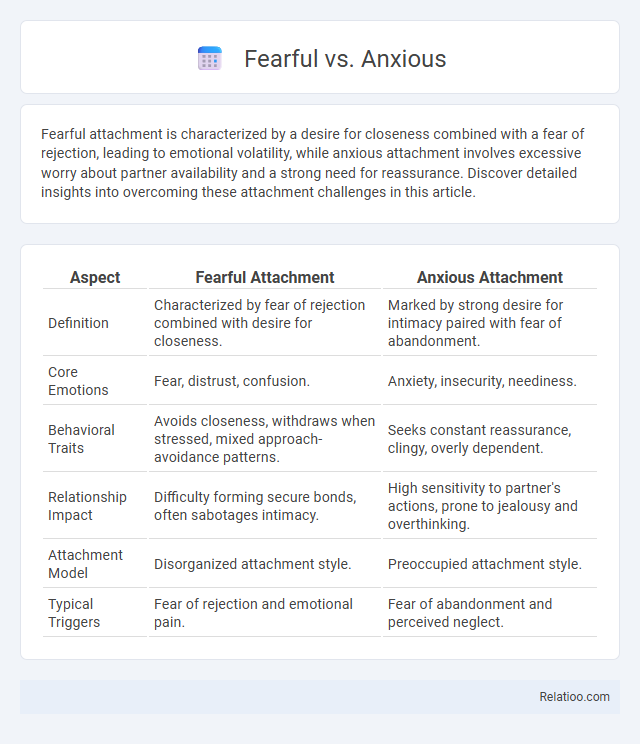Fearful attachment is characterized by a desire for closeness combined with a fear of rejection, leading to emotional volatility, while anxious attachment involves excessive worry about partner availability and a strong need for reassurance. Discover detailed insights into overcoming these attachment challenges in this article.
Table of Comparison
| Aspect | Fearful Attachment | Anxious Attachment |
|---|---|---|
| Definition | Characterized by fear of rejection combined with desire for closeness. | Marked by strong desire for intimacy paired with fear of abandonment. |
| Core Emotions | Fear, distrust, confusion. | Anxiety, insecurity, neediness. |
| Behavioral Traits | Avoids closeness, withdraws when stressed, mixed approach-avoidance patterns. | Seeks constant reassurance, clingy, overly dependent. |
| Relationship Impact | Difficulty forming secure bonds, often sabotages intimacy. | High sensitivity to partner's actions, prone to jealousy and overthinking. |
| Attachment Model | Disorganized attachment style. | Preoccupied attachment style. |
| Typical Triggers | Fear of rejection and emotional pain. | Fear of abandonment and perceived neglect. |
Understanding Fear and Anxiety: Key Differences
Fear is an immediate, short-term response to a known or definite threat, activating the body's fight-or-flight mechanism, whereas anxiety involves a prolonged, diffuse feeling of apprehension or worry about potential or uncertain dangers. Fear triggers a direct physiological reaction with clear cause and effect, while anxiety often lacks a specific source and can affect cognitive functions and behavior over time. Recognizing these distinctions is crucial for effective clinical diagnosis and treatment of related mental health conditions.
The Science Behind Fear and Anxiety
Fear activates the brain's amygdala, triggering the fight-or-flight response critical for survival, while anxiety involves prolonged activation of this system, often linked to the prefrontal cortex's role in anticipation and worry. Neuroscientific research shows fear responses are immediate and specific to present threats, whereas anxiety is diffuse, involving hypervigilance to potential future dangers. Understanding these distinctions aids in developing targeted treatments such as exposure therapy for fear and cognitive-behavioral interventions for anxiety disorders.
Common Triggers for Fearful and Anxious Responses
Common triggers for fearful responses often include immediate threats to physical safety, such as sudden loud noises, dangerous animals, or imminent harm, activating the body's fight-or-flight reaction. Anxious responses are typically triggered by anticipatory concerns about uncertain future events, social evaluations, or prolonged stressors that create a persistent sense of worry or unease. Understanding the distinct triggers helps differentiate fear, which is a direct response to present danger, from anxiety, which is characterized by apprehension about potential, non-imminent threats.
Physical Symptoms: Fear vs. Anxiety
Fear triggers an immediate physical response characterized by increased heart rate, rapid breathing, and muscle tension due to the activation of the sympathetic nervous system. Anxiety involves more prolonged physical symptoms such as restlessness, fatigue, headaches, and gastrointestinal issues resulting from chronic stress activation. While fear is a direct reaction to a specific threat, anxiety manifests as a persistent state of apprehension with less intense but more sustained physical effects.
Emotional Impact: How Fear and Anxiety Manifest
Fear manifests as an immediate emotional response to a specific, identifiable threat, triggering the body's fight-or-flight reaction and sharp physiological changes like increased heart rate and heightened senses. Anxiety, in contrast, involves a more diffuse, prolonged emotional state characterized by unease and worry about potential future threats without a clear cause, often leading to chronic stress and restlessness. The emotional impact of fear is often intense but short-lived, while anxiety can cause ongoing distress, impairing daily functioning and mental health over time.
Behavioral Reactions to Fear versus Anxiety
Behavioral reactions to fear typically involve immediate, fight-or-flight responses such as fleeing, freezing, or confronting a clear threat, driven by a specific and identifiable danger. Anxiety triggers more prolonged behaviors like avoidance, excessive worry, or hypervigilance, reflecting uncertainty about future potential threats or outcomes. Understanding the distinction in your reactions can help manage these emotional states more effectively by tailoring coping strategies to either acute fear or chronic anxiety.
Short-Term vs. Long-Term Effects
Fear triggers immediate, short-term responses like increased heart rate and heightened alertness, while anxiety often manifests as prolonged worry impacting your mental health and daily functioning. Fearful reactions tend to subside once the threat fades, whereas anxious states can persist, leading to chronic stress and potential long-term psychological issues. Understanding these distinctions helps you manage emotional responses effectively, improving both short-term coping and long-term well-being.
Coping Mechanisms for Fearful and Anxious Feelings
Coping mechanisms for fearful feelings often involve grounding techniques that help you stay present, such as deep breathing exercises, progressive muscle relaxation, and mindfulness meditation to reduce immediate panic responses. Anxious feelings may require a combination of cognitive-behavioral strategies, including identifying and challenging negative thought patterns, practicing regular physical activity, and establishing a consistent routine to manage chronic worry. Targeted support, such as therapy or support groups, can provide personalized tools to effectively address both fear and anxiety, promoting emotional resilience.
When to Seek Professional Help
You should seek professional help if your fearful or anxious feelings persist for weeks, interfere with daily activities, or cause intense distress. Symptoms such as panic attacks, overwhelming worry, or avoidance behaviors indicate that therapy or medical intervention may be necessary. Early treatment with a mental health professional improves outcomes and provides effective coping strategies.
Practical Tips for Managing Fear and Anxiety
Fearful individuals often react to specific, identifiable threats, while anxious individuals experience diffuse, anticipatory worry without a clear cause. Practical tips for managing both include practicing mindfulness meditation to increase present-moment awareness and reduce physiological arousal, implementing cognitive-behavioral techniques such as grounding exercises and systematic desensitization, and maintaining regular physical activity to alleviate stress hormones. Consistent use of these strategies helps modulate the amygdala's response and enhances emotional regulation, improving overall mental resilience.

Infographic: Fearful vs Anxious
 relatioo.com
relatioo.com